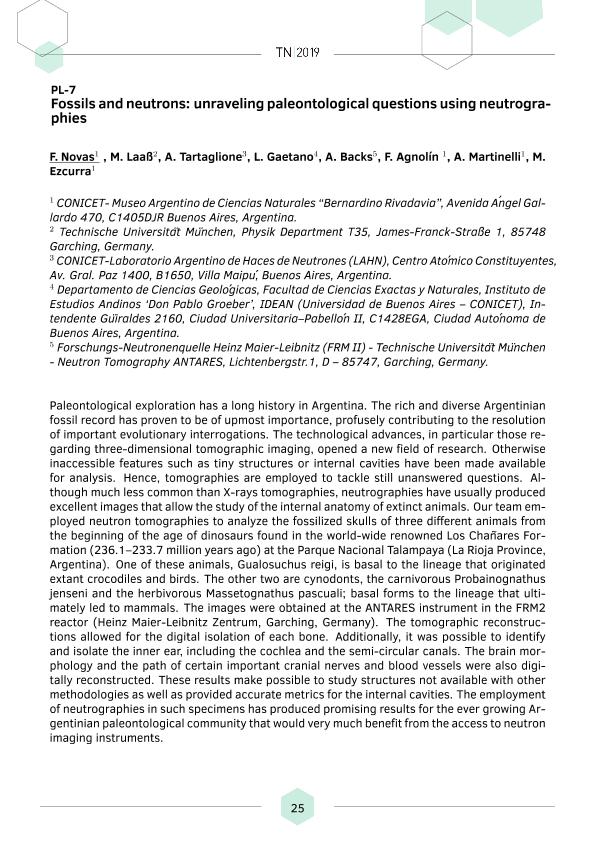Evento
Fossils and neutrons: unraveling paleontological questions using neutrographies
Novas, Fernando Emilio ; Laaẞ, Michael; Tartaglione, Aureliano
; Laaẞ, Michael; Tartaglione, Aureliano ; Gaetano, Leandro Carlos
; Gaetano, Leandro Carlos ; Backs, Alexander; Agnolin, Federico
; Backs, Alexander; Agnolin, Federico ; Martinelli, Agustín Guillermo
; Martinelli, Agustín Guillermo ; Ezcurra, Martin Daniel
; Ezcurra, Martin Daniel
 ; Laaẞ, Michael; Tartaglione, Aureliano
; Laaẞ, Michael; Tartaglione, Aureliano ; Gaetano, Leandro Carlos
; Gaetano, Leandro Carlos ; Backs, Alexander; Agnolin, Federico
; Backs, Alexander; Agnolin, Federico ; Martinelli, Agustín Guillermo
; Martinelli, Agustín Guillermo ; Ezcurra, Martin Daniel
; Ezcurra, Martin Daniel
Tipo del evento:
Congreso
Nombre del evento:
II Congreso Argentino de Técnicas Neutrónicas
Fecha del evento:
08/05/2019
Institución Organizadora:
Comisión Nacional de Energía Atómica;
Laboratorio Argentino de Haces de Neutrones;
Título del Libro:
Resúmenes II Congreso Argentino de Técnicas Neutrónicas
Editorial:
Centro Cultural de la Ciencia
Idioma:
Inglés
Clasificación temática:
Resumen
Paleontological exploration has a long history in Argentina. The rich and diverse Argentinian fossil record has proven to be of upmost importance, profusely contributing to the resolution of important evolutionary interrogations. The technological advances, in particular those regarding three-dimensional tomographic imaging, opened a new field of research. Otherwise inaccessible features such as tiny structures or internal cavities have been made available for analysis. Hence, tomographies are employed to tackle still unanswered questions. Although much less common than X-rays tomographies, neutrographies have usually produced excellent images that allow the study of the internal anatomy of extinct animals. Our team employed neutron tomographies to analyze the fossilized skulls of three different animals from the beginning of the age of dinosaurs found in the world-wide renowned Los Chañares Formation (236.1?233.7 million years ago) at the Parque Nacional Talampaya (La Rioja Province, Argentina). One of these animals, Gualosuchus reigi, is basal to the lineage that originated extant crocodiles and birds. The other two are cynodonts, the carnivorous Probainognathus jenseni and the herbivorous Massetognathus pascuali; basal forms to the lineage that ultimately led to mammals. The images were obtained at the ANTARES instrument in the FRM2 reactor (Heinz Maier-Leibnitz Zentrum, Garching, Germany). The tomographic reconstructions allowed for the digital isolation of each bone. Additionally, it was possible to identify and isolate the inner ear, including the cochlea and the semi-circular canals. The brain morphology and the path of certain important cranial nerves and blood vessels were also digitally reconstructed. These results make possible to study structures not available with other methodologies as well as provided accurate metrics for the internal cavities. The employment of neutrographies in such specimens has produced promising results for the ever growing Argentinian paleontological community that would very much benefit from the access to neutron imaging instruments.
Palabras clave:
FOSSILS
,
NEUTRONS
,
PALEONTOLOGY
Archivos asociados
Licencia
Identificadores
Colecciones
Eventos(IDEAN)
Eventos de INSTITUTO DE ESTUDIOS ANDINOS "DON PABLO GROEBER"
Eventos de INSTITUTO DE ESTUDIOS ANDINOS "DON PABLO GROEBER"
Citación
Fossils and neutrons: unraveling paleontological questions using neutrographies; II Congreso Argentino de Técnicas Neutrónicas; Ciudad Autónoma de Buenos Aires; Argentina; 2019; 25-25
Compartir



